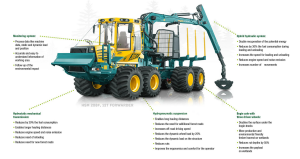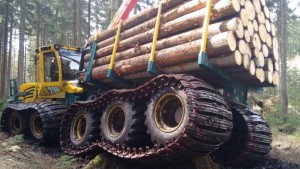Forest biomass is currently one of the most important sources of renewable energy and accounts for almost half of the EU´s total renewable energy consumption; this is in addition to the very important use of round wood from forests. Besides raw materials, forests also provide a wide range of vital non-wood services that should be protected during wood extraction. In order to make forestry sustainable, it is essential to use commercial vehicles that will affect the forest ecosystem as little as possible. To achieve this forest machine manufacturer Hohenloher Spezial Maschinenbau GmbH & Co. KG (HSM) has launched the innovation project Forwarder2020: main aim of the project is improving the sustainability of wood production and delivery as well as operational forest management and planning. Within the project innovations for more efficient forwarders, essential wood extraction and transportation vehicles will be developed and tested under real conditions.
Over the course of 3 years (2016-2019) project coordinator HSM together with 13 European partners from industry and science in 6 countries will work on 5 innovative modules for forwarders. So they will gather their expertise to advance diverse technologies, which will contribute to smart and sustainable logging operations using innovative forestry machines.

The innovations targeted (fig. 1) concern a more efficient power-split hydrostatic-mechanical transmission, a hydro-pneumatic suspension, a new hydraulic system for the crane with energy recuperation, a bogie axle with three driven wheels for the timber load and a new monitoring system for documentation and active operations control.
The importance of innovative forestry machines
The combined effect of these innovative modules will be to reduce the fuel consumption by 30% and the impact on the soil (reduction of rut depth and dynamic wheel load) by 30%. They also allow more precise planning of the tracks and documentation of the loads carried on. Altogether the innovations will contribute to reduce the environmental impact of forest management and harvesting operations while cutting operating costs and reducing the risks of occupational disease for forest operators. Finally, the company HSM and the consortium expect to supply to the market a unique and modular system of competitive high-end solutions which offers the customer the possibility to choose its equipment and then bear no higher costs for the modules not chosen.
“In the effort of rendering the forest operations more sustainable, forwarders are of particular interest because these forestry machines have the highest wheel-load and the biggest impact on unpaved forest soils. They also bridge big travelling distances between the felling points in the stand and the road side timber depots. The reduction of the fuel consumption, of the impact of the machine on the soil and on the health of the operators through the Forwarder2020 innovative modules will then be of prime importance not only for the sustainability of the logging but also on the economic potential of the forestry companies, our clients. “, states Mr. Felix Fürst zu Hohenlohe-Waldenburg, coordinator of Forwarder2020 project and CEO at HSM.
The Forwarder2020 prototype

The integration of 3 out of the 5 innovative modules into a completely running first prototype is achieved by now and field tests under harsh forest conditions were carried out from 28th March to 13th April 2018 under operation of Forstdienstleistungen Hegenbarth (FDH) and supervision of Bern University of Applied Sciences (BFH) in Saxony. The test site is located near Grillenburg, Saxony and is owned by “Staatsbetrieb Sachsenforst”. The forwarding was part of salvage harvesting operations on a wind thrown spruce dominated stand. The tests included preparative test runs, hardship tests, but were dominated by the scientific time study and reference cycle generation. The data evaluation of these field tests is still in progress. However it is evident that the tests had been very satisfying. The machine works very well and without any failures. The rut depths caused by the bogie tracks are even lower than expected. The data transmission to the monitoring system as well as the cloud connection worked well for different data resolution setups up to high resolution stress level tests.
The machine will be ready for the transport to the demonstration site in Scotland by the end of April. In Scotland further tests under forest conditions will continue in May 2018 and later on the machine will be tested additionally in Lithuania. The second prototype will be ready for first full field tests in autumn and will be tested under forest conditions in Romania.
About Forwarder2020
The project has been officially launched on the 6th of October 2016 at the HSM premises in Wolfegg. It has an overall budget of 3 M€ and is co-funded by the European Commission with 2 M€ under the European Research and Innovation programme Horizon 2020.
For more information on Forwarder2020 and to stay updated on the project’s activities and progress, please see Forwarder2020 website.
This article is by Janina Kouvaris, Steinbeis-Europa-Zentrum (SEZ).


